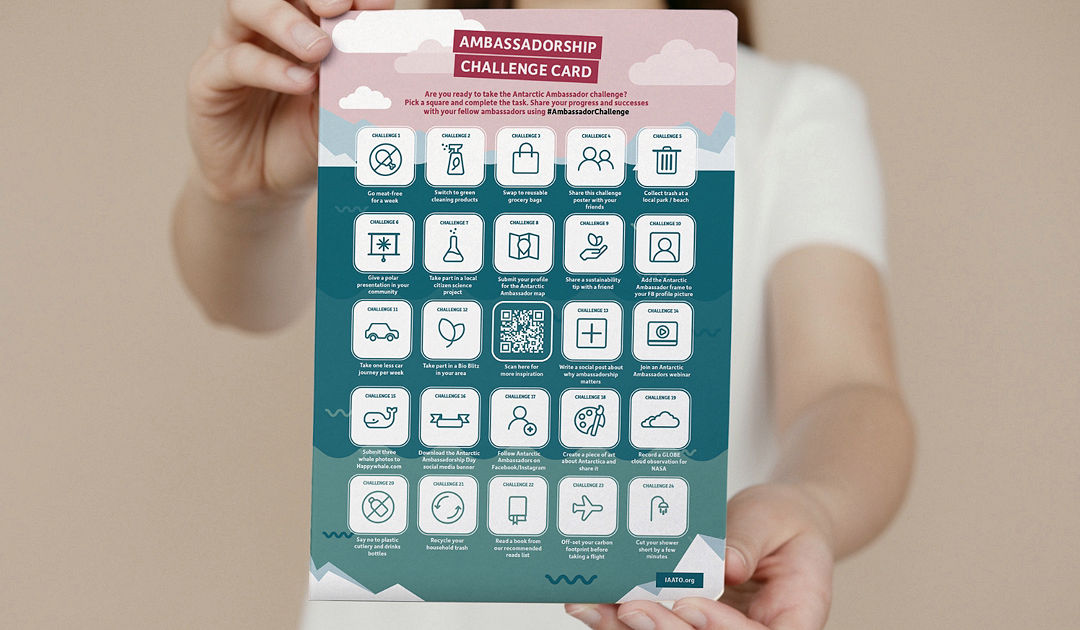
Travelers to Antarctica are usually fascinated and enthralled by the beauty, size, animals, and apparent pristine nature of the icy landscape. At the same time, they are also confronted with a lot of facts and information, conveyed by experienced expedition teams, about the dangers threatening Antarctica and the connections with the rest of the world, resulting in a desire on the part of some visitors to do more to protect Antarctica, the climate and the environment. The Interantional Association of Antarctic Tour Operators IAATO promotes this with its Antarctic Ambassador Program and has now launched a new tool to do so.
The “Ambassadorship Challenge” launched by the IAATO consists of 24 tasks and opportunities to implement changes at home that help do more to protect the climate and the environment. Tasks are listed on a card for participants to check off as they complete them. The card is available on the IAATO website and can be downloaded by anyone who wants to participate (link at the end of the article). The tasks can be completed both in the specified order or randomly. As a further incentive, each month IAATO publishes a task on its Facebook page for participants to take part in. On the site, participants can then exchange ideas with other participants, post their successes, and support and inspire each other.


The goal of the Ambassadorship Challenge is to inspire people around the world to consider their own impact on the environment and climate. For both climate change and environmental pollution have been declared in a UN report to be the greatest dangers in the coming years for the well-being of mankind and also threaten the seemingly distant Antarctic. Visitors to Antarctica should also be made aware of this in the course of their voyages. “Every year, people return from Antarctica inspired to take action to protect Antarctica,” explains Hayley Collins, IAATO’s communications manager. These people can act as Antarctic ambassadors for the region and its conservation at home, making a difference with positive changes that may look like small steps, but can have a larger effect when taken as a whole. “This challenge is designed as a starting point for would-be Antarctic Ambassadors, or to kick things up a notch for those who have been Ambassadors for a while.” However, the Challenge is not only intended to appeal to visitors themselves, but they can also invite others around them to participate. “There’s something for every age and ability, so Ambassadors can get their families involved, too,” Hayley Collins continues.

The Ambassadorship Challenge was developed by IAATO’s internal Education and Outreach Working Group and is part of IAATO’s Antarctic Ambassadors Program. This program, launched as part of the association’s 30th anniversary, aims to show that tourism and environmental or climate protection do not cancel each other out, but that more can be done to protect the environment through responsible travel. With this challenge card in particular, IAATO wants to show that there is more to take away from Antarctica than just nice pictures and memories. For example, the tasks on the card include picking up trash in a park, in the forest, or on the beach. To make this a bit more interesting and entertaining, a kind of “clean-up bingo” was developed from this, which can also be downloaded.
Critics of tourism activities argue that these very trips contribute to the destruction of Antarctica and that such ambassador programs are just shams and marketing strategies. However, this is countered by the consideration that direct experience, seeing and feeling and the information conveyed in the process creates a concrete awareness of climate and environmental protection. A study currently being conducted by an independent party will show whether the principle is actually successful. “Ambassadorship has been a cornerstone of IAATO since its inception 32 years ago, and we are thrilled to be putting out resources which can inspire and motivate others to do their part for Antarctica too,” says Steve Jones of the Working Group. “The card is a resource we’re proud of and an excellent addition to our growing library of Antarctic Ambassador resources.”
Dr Michael Wenger, PolarJournal
To get involved, download your ambassador card here and join the discussion on the Antarctic Ambassadors Facebook page.
More on the topic





